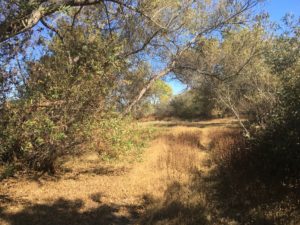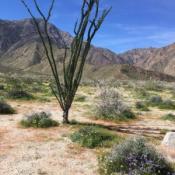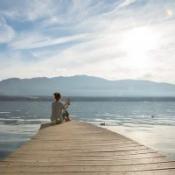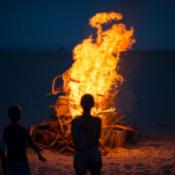 Madrona Marsh is a wetlands reserve in the city of Torrance, California. It’s a study in contrasts: a former oil field, it used to be riddled with pavement and oil rigs, but is now restored to a beautiful, green, seasonal wetland with vernal pools. However, it’s one tiny patch of green located smack in the middle of hundreds of square miles of gray urban concrete.
Madrona Marsh is a wetlands reserve in the city of Torrance, California. It’s a study in contrasts: a former oil field, it used to be riddled with pavement and oil rigs, but is now restored to a beautiful, green, seasonal wetland with vernal pools. However, it’s one tiny patch of green located smack in the middle of hundreds of square miles of gray urban concrete.
I was sitting in the middle of it on a sunny Saturday afternoon because I’m taking a course to become certified as a naturalist.
“Go find a place to sit for an hour,” said our professor, Lauren. “Alone. Preferably not in view of any other person. No talking to anyone, either. Sit there and see what you see. See what comes to you as you sit quietly. Nature will come if you just sit still. Notice how you feel. Write about all of it in your nature journal.”
“And remember,” she added, “a naturalist becomes a part of the landscape, the ecosystem they are observing. You will move differently through it than, say, a hiker would.”
As a therapist, my specialty is in helping people improve their self-regulation: the dynamic balance of internal energies, how they respond to their own feelings and to the outside world. We do a lot of noticing body sensations, movement impulses, and how they generally feel inside. I’m no stranger to this myself, as I, too, have regular somatic therapy sessions—to keep a “clean slate” for the people who come to see me, and to continue with my own healing. So, I wasn’t entirely surprised this assignment would give me another dose of my own “medicine.”
Our group of students crossed the road and headed back into the heart of the marsh, where we had spent the morning with an expert naturalist. She helped us learn to notice the subtle nuances of this small but complex ecosystem. As we closed the gates behind us, I noticed a familiar stress inside. It was the stress of feeling squeezed, of competing for limited resources—in this case, space. There were 25 of us, and I wasn’t sure we could all find a nice, shady place to settle in alone.
I noticed the inherent calm beauty of the marshlands, now dry for the season and radiating the sun’s warmth. I noticed the contrast between the land and how I felt inside. These survival-based energies come from deep within. They are primal and they are automatically summoned far too frequently in the complex stress of modern living. I reflected on how much this push drains me—literally draining my body’s energy.
As I managed to get away by myself, the pace of my walk naturally slowed. The sun, which had felt too hot just a few hours ago, now radiated a perfect gentle warmth to my skin. I noticed I was automatically and intuitively connecting with my felt sense. As Lauren had described earlier, I was beginning to become a part of the landscape instead of an intruder tromping through it. All of my senses seemed to sharpen. My feet placed themselves deliberately and the noise of my walking diminished considerably. Earlier, my socks had collected many of those large, painful cockleburrs; now, with the new way I was moving, I wasn’t collecting any—and it wasn’t because I was consciously watching for them. In fact, I wasn’t consciously causing any of these changes.
As I moved toward a grove of nearby trees, I savored the warm feeling of the sun. My breath slowed and deepened, no longer caught higher in my chest. My belly also felt spacious inside, not constricted. Again, I reflected on the conditions that most of us urbanites endure on a daily basis. I love cities, and I especially adore my city. But, there’s always someone in line ahead of me, taking their time despite the pressure of my schedule. Or there’s someone honking me along faster from the car behind, not mindful of the slow-moving vehicle ahead of me. Bills are due, schedules are packed. There’s always the temptation to cross off just one more item on the to-do list. It is no longer a natural part of daily life to pause and simply be for a moment, surrounded by nature.
I wondered: How much of myself am I spending on a day-to-day basis just to move through this modern environment?
Many of my days are focused on helping people come into better self-regulation. Does today’s urban environment limit how self-regulated we can become? It seems a fair question. I don’t know the answer.
Noticing movement out of the corner of my eye, I paused. A grasshopper had hopped out of my path and onto a nearby shrub. Now, there is a major difference between the naturalist studies of Charles Darwin’s time and ours—and that difference is technology. I have become enamored of an app called iNaturalist. You can take a photo of any living part of an ecosystem—tree, shrub, insect, animal—and use this app to upload your photo to the internet. The app will suggest for you what genus and species it might be, and it records your observation of that species at that time and in that location. If your guess or the app is wrong about the species, many dedicated citizen naturalists will notice, and they will gently suggest a correction. This is creating a large, worldwide database of what species appear where at what times.
These days, many of us feel anxiety when we think about our natural environment. Ecotherapists have a term for this: eco-anxiety. It is a normal and reasonable response to the widespread devastation that our species has created. However, here I was experiencing the opposite.
As my instructor had noted, citizen science is becoming quite a powerful force in studying and preserving biodiversity, and I am delighted to be contributing to it. Earlier in the morning, I had tried to get a photo of one of these critters, but they were just too fast for me. Now, however, I found myself calmer, less charged, and more patient. I still couldn’t get super close; I had to use the zoom feature on my phone’s camera, but I was able to snap and upload the photo. (It was later identified as a spur-throated grasshopper, of the genus melanoplus.)
I settled myself under a beautiful willow tree and waited. A hummingbird came—once, twice, now three times—to buzz its wings around my head and check me out. It was gorgeous, and there was no way it was going to hold still for my slow, weak phone camera, so I just sat there and took it in. (This was clearly the better choice anyway.) I looked down at the ground around me and noticed a thin, dried, spongy brown crust all over the ground. That’s right, I thought—this is a seasonal wetland, so that must be algae or moss that had dried out, awaiting revival from fall rains.
I marveled at the sheer diversity of the small (some tiny) plants around me. There were so many, and they looked so different from each other! I remembered what Lauren had said: From the micro-organisms in the soil to the smallest insects and plants, each living thing is part of the web of life. Each one serves, or is served by, the next creature in the web. I could see the intricacy right there in front of my eyes. My shoulders dropped as I forgot about paperwork and the inevitable traffic jam on the way home. It may seem as though I am making this stuff up, for the benefit of this article, in order to drive home my point about the value of nature. But I’m not. Rather, this point drove itself home to me as I sat there in that marsh and reexperienced my connection with the natural world.
These days, many of us feel anxiety when we think about our natural environment. Ecotherapists have a term for this: eco-anxiety. It is a normal and reasonable response to the widespread devastation that our species has created. However, here I was experiencing the opposite. Biophilia is the name for our innate tendency to be drawn to, and to love, nature and other living things. It is a powerful and often overlooked force in our self-regulation.
I think it’s also noteworthy that I was experiencing this on a restored site. This place used to be literally trashed by oil, pavement, and invasive plant species (which tend not to provide much food or shelter for the native critters). Today, the wetlands have been nurtured back, and this site serves as a vital stop for many birds on the Pacific Flyway, the route used by migrational birds as they traverse large portions of the globe. Restoration is valuable!
Nature is valuable.
We are valuable to nature.
It’s a win-win situation.
There are so many things we can do to support nature—and to invite nature back into our lives to support us. There are tiny things, like walking or ride-sharing instead of driving, saying no to a plastic bag, or uploading a data point to iNaturalist. There are huge things, like hiking the Appalachian Trail and then giving talks about it around the country, or sitting in a tree to prevent the forest from being destroyed. And there are many things in between, like taking part in a beach or forest cleanup day or choosing foods (and packaging) that don’t have a harsh impact on nature.
If you checked in with yourself and considered reconnecting with nature, what manageable, doable steps could you take? What would feel right to you?
Would you take a little time out of your busy life, prepare, and then actually do it?
© Copyright 2017 GoodTherapy.org. All rights reserved.
The preceding article was solely written by the author named above. Any views and opinions expressed are not necessarily shared by GoodTherapy.org. Questions or concerns about the preceding article can be directed to the author or posted as a comment below.

 Of Wildflowers and Worries: Living in an Age of Eco-Anxiety
Of Wildflowers and Worries: Living in an Age of Eco-Anxiety Is the Life You’re Living in Tune with Your Natural Rhythms?
Is the Life You’re Living in Tune with Your Natural Rhythms? Love and Connection: How Trauma Can Bring Us Closer Together
Love and Connection: How Trauma Can Bring Us Closer Together